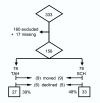Supracervical hysterectomy versus total abdominal hysterectomy: perceived effects on sexual function
- PMID: 11825343
- PMCID: PMC65528
- DOI: 10.1186/1472-6874-2-1
Supracervical hysterectomy versus total abdominal hysterectomy: perceived effects on sexual function
Abstract
BACKGROUND: Our investigation sought to compare changes in sexual function following supracervical hysterectomy (SCH) and total abdominal hysterectomy (TAH). METHODS: A retrospective chart review was performed to identify all patients who underwent supracervical hysterectomy or total abdominal hysterectomy at a tertiary care center. Patients who met criteria for participation were sent a one page confidential, anonymous questionnaire to assess sexual function experienced both pre- and postoperatively. A total of 69 patients in each group were eligible for participation. A multiple logistic regression model was used to analyze measured variables. RESULTS: Forty-eight percent (n = 33) of women undergoing a SCH returned the questionnaire, while 39% (n = 27) of those undergoing a TAH chose to participate. There were no significant demographic differences between the two groups. Patients who underwent TAH reported worse postoperative sexual outcome than SCH patients with respect to intercourse frequency, orgasm frequency and overall sexual satisfaction (P = 0.01, 0.03, and 0.03, respectively). Irrespective of type of hysterectomy, 35% of patients who underwent bilateral salpingoophorectomy (BSO) with hysterectomy experienced worse overall sexual satisfaction compared to 3% of patients who underwent hysterectomy alone (P = 0.02). CONCLUSIONS: Our data suggest that TAH patients experienced worse postoperative sexual function than SCH patients with respect to intercourse frequency and overall sexual satisfaction. Irrespective of type of hysterectomy, patients who underwent bilateral salpingoophorectomy experienced worse overall sexual satisfaction.
References
-
- Wilcox LS, Koonin LM, Pokras R, Strauss LT, Zhisen X, Peterson HB. Hysterectomy in the United States, 1988–1990. Obstet Gynecol. 1994;83:549–55. - PubMed
-
- Morley GW. Indications for hysterectomy. In: Thompson JD, Rock JA, editor. TeLinde's Operative Gynecology Updates. Vol. 1. Philadelphia: JB Lippincott;; 1993. pp. 1–11.
LinkOut - more resources
Full Text Sources
Miscellaneous


